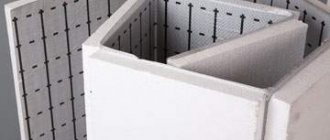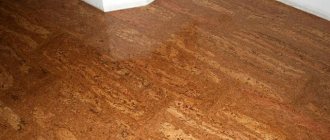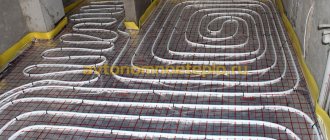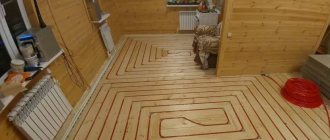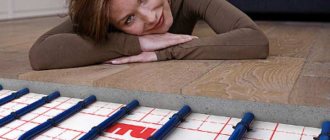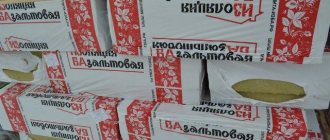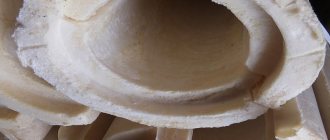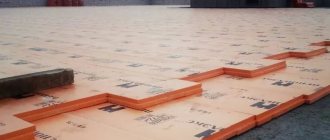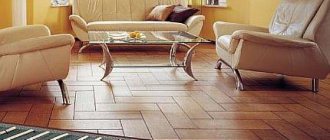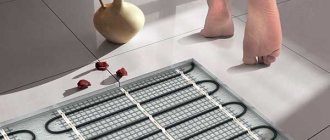Heating a home using underfloor heating is becoming increasingly popular. These systems vary in the type of heating elements, allowing you to choose for any home. In order for such a heating system to operate efficiently and reliably, it must be properly insulated. To ensure that the heat does not escape in vain, the underfloor heating is intended. It is made of heat-reflecting materials that will retain heat.
Lavsan - description and basic properties of the material
Polyethylene terephthalate (PET or lavsan) is a thermoplastic from the polyester class. The material is durable, resistant to wear and moisture. Polyester film is used in various industries - from the manufacture of packaging for food and medicine, to the lamination of fabric used for thermal insulation. Wide possibilities of use are due to the properties of polyester: frost resistance, low vapor and gas permeability, wear and tear resistance.
Metallized film is offered for thermal insulation of floors, roofs, walls, pipelines and ventilation systems. It is a composite of aluminum and lavsan. The reflective material is welded with gas-foamed polyethylene, which increases the resistance to heat and sound transmission.
The thickness of the metal layer determines the reflectivity of the insulation; if it is extremely thin, then infrared radiation is weakly reflected. The size and quality of aluminum insulation coating cannot be determined visually, so to protect yourself from counterfeiting, you should buy products from well-known brands: Izolon, Izodom, Penoplus, Thermodom.
Lavsan insulation, soldered to a polyethylene foam base, has several important advantages:
- low thermal conductivity;
- sound insulation effect due to the presence of air layers;
- protection from moisture and steam due to the surface density and resistance of the film to moisture;
- low weight and thickness of the insulation layer do not create a load on the structure and do not take up free space;
- fire safety, the canvas does not burn and does not emit toxic smoke;
- resistance to chemical reagents (acids and alkalis);
- dielectric properties.
Substrate requirements
There are three types of heated floors on the heating equipment market today:
You can find out the price and buy heating equipment and related products from us. Write, call and come to one of the stores in your city. Delivery throughout the Russian Federation and CIS countries.
Each type has its own design and functioning features, advantages and disadvantages, and they are installed using different technologies. In order to choose the most optimal option for heated floors, be sure to take into account all the features of each type.
One of the important conditions that must be observed when installing any type of heated floor is laying the underlying material (substrate).
Thermal reflective lining is placed between the concrete base and the heating system. The purpose of this part is to raise heat straight up. When choosing a substrate, pay attention to its quality and thickness.
Also, materials acting as bedding must meet the following requirements:
- environmental friendliness;
- safety;
- good sound insulation;
- simple installation;
- ability to withstand temperature changes.
Thanks to underfloor heating, you can retain 80-90% of heat and reduce energy costs.
Typically, the substrate is polypropylene or polyethylene foam, which is covered with a Mylar film with a metallized layer. It is thanks to this layer that heat is evenly distributed throughout the room, and foamed polyethylene prevents heat from escaping into the screed.
In addition, the foam backing for heated floors is characterized by low thermal conductivity, which means that heat will not escape into the screed and ceiling.
The substrate not only has high thermal insulation and waterproofing properties, it also has a high level of sound insulation.
Technical characteristics of lavsan thermal insulation
The universal material meets sanitary requirements and is safe for human health thanks to the use of environmentally friendly substances. PET is used as packaging for products, and aluminum is a natural material. When energy is reflected, the metallized surface maintains room temperature without heating up under the influence of heat. The use of lavsan allows you to reduce the thickness of the main insulation (mineral wool or polystyrene foam) without reducing the level of insulation.
The insulation is produced in rolls 25-50 m long and 1 m wide, thickness is 2-10 mm.
Foamed polyethylene of increased strength, laminated with lavsan, has the following technical characteristics:
- reflective effect - 90%;
- thermal conductivity coefficient - 0.035 W/m*K;
- vapor permeability - 0.001;
- water absorption - 1-2%;
- operating temperature - from −60º to +100º C;
- density - 30-45 kg/cubic. m.
Using lavsan film when installing “warm” floors
Lavsan insulation has gained particular popularity as a substrate when installing a “warm” floor system. For heating to work effectively, even heat distribution is necessary. Reflective insulation prevents energy loss through the base, and the infrared waves emitted by the heating element are reflected into the room. The waterproofing properties of the insulation protect the system from moisture penetration from the ground or basement. It has sufficient strength to deformation, is elastic, and can withstand high loads.
The expediency of using lavsan film is determined by its resistance to aggressive environments. Concrete screed with prolonged contact causes corrosion of the metal, so replacing aluminum foil with lavsan extends the life of the substrate.
The reflective substrate works to uniformly distribute warm air with any type of heated floor, but it is indispensable when laying electric cables and infrared floors. Lavsan insulation is a dielectric and ensures complete operational safety of the system, preventing the possibility of short circuits.
When laying thermal insulation, the sheet must be distributed over the entire area of the base, not excluding places where it is not planned to install an infrared floor. The joints of the insulating strips are glued with special foil tape. The reflective layer is directed towards the room.
This type of underlay is most often used when the final floor covering is ceramic tiles. This material has a cold surface and requires intense heating.
What does saving on insulation lead to?
For example, let's take a room with an area of 50 square meters.
Usually they use polystyrene foam with bosses, the cost is 1 sq. meter on average 600 rubles, thickness - 2 cm. In most cases, this thickness is not enough for insulation, with the exception of the southern regions. Additional insulation up to 4 cm will cost another 150 rubles per square meter. The total amount will be 7,500 rubles. Saving this amount is what we are talking about when choosing insulation. The owner of the house strives to cut costs and often chooses the cheapest option - underlayment for heated floors, instead of the insulation itself. Ultimately, the thrifty home owner heats the outdoors and spends even more money to maintain a comfortable indoor temperature.
Calculation of the cost of water heated floors
We have two rooms in front of us:
- the first with normal, high-quality insulation of the required thickness;
- the second - with a substrate for a warm floor under insulation and a “thrifty” owner.
| Characteristic | House No. 1 | House No. 2 |
| Floor area | 50 | 50 |
| Pipe temperature | 40 | 40 |
| Pipe diameter | 16 | 16 |
| Insulation | 60 | 20 |
| Heat flow upward | 73,76 | 65,81 |
| Heat flow down | 18,88 | 58,72 |
| Maximum floor temperature | 26,82 | 26,18 |
In the first house, with 4 cm of insulation, the heat flow into the room exceeds the heat flow down three times. All the heat that the owner of the house pays for is used to heat the room, not the street! In the house of a “frugal” owner, the heat flow upward (to the room that needs to be heated) is almost equal to the heat flow downward (to the street, to nowhere). Forty watts per square meter go down the drain.
- On 1 square meter with underfloor heating we lose 40 W, on 50 square meters - 2000 W.
- 1 cubic meter of natural gas provides 10 kW of thermal power and costs 4.5 rubles (the price depends on the region, from 4 to 8 rubles).
- 10 00 W/2000 W = 5 hours – this is how much 1 cubic meter of natural gas is enough for heat loss.
- The boiler operates on average 12 hours a day. 12/5=2.4 cubic meters of gas are spent per day on heating the street.
- 2.4 (cubic meters) x 4.5 (rubles) x 30 (days) x 7 (months of the heating period) = 2,268 rubles per year.
They paid 7,500 rubles for the insulation / 2,268 rubles = 3.3 years - the payback period for the insulation. When using underfloor heating, heat losses will increase! These materials are not insulation!
When using insulation materials with insufficient thickness for complete thermal insulation or when using foil insulation, isoline (they are also a substrate for a heated floor), the owner of the house loses a lot of heat in the lower direction. This is either unreasonable savings or a serious misconception of the homeowner. Heat losses in this case are comparable to the heat flow entering the room. The use of high-quality insulation of the required thickness pays off in an average of 3-3.5 years of operation of a heated floor, when using natural gas as an energy source. Natural gas is the cheapest source of energy. If we talk about other sources, then insulation can pay for itself in 1 heating period (i.e. in 7 months).
Scope and installation features of reflective insulation
Thermal insulation with a metallized layer is manufactured in accordance with all hygienic standards and is a low-flammability material. Thanks to its small size, it does not cause problems during transportation and installation. The rolls are easy to cut, and for fastening you only need a construction stapler and special tape.
Reflective insulation effectively reduces the heat loss of a building when combined with the main insulation. Installation of the canvas with lavsan film provides protection from steam and moisture. Its use as part of a roofing pie is possible outside and from the attic. Insulation of the roof under the roof covering is carried out while eliminating noise and protecting against moisture penetration. The canvas is attached to the sheathing with a stapler, the joints are taped with tape. The reflective layer is directed upward. The finished insulation is covered with a counter batten for the finishing coating.
When attaching insulation, it is necessary to provide an air gap of at least 20 mm between the insulation and the outer cladding. Reflective ability, resistance to moisture and high temperature allow the material to be used when finishing baths and saunas. When insulating a balcony, polyethylene foam with lavsan is the best choice. A thin layer of insulation does not take up the space of a small room, while it performs the function of vapor and waterproofing and does not require the creation of additional layers.
What kind of substrate to lay under a film heated floor
- Content:
- Is it necessary to lay underlay under the IR floor?
- What does a layered “pie” look like?
- What kind of substrate is laid under a heated floor?
- What additional thermal insulation is needed?
Warm infrared floors appeared relatively recently and have already gained popularity. This happened due to low cost and the possibility of self-installation. Most operating instructions indicate that a substrate must first be laid under the film heated floor. What is it for?
We carry out installation
As an example, let’s look at the installation of film heated floors.
There are following instructions:
- We lay the thermal insulation substrate on the cement base.
The underlay under the laminate for heated floors is laid end-to-end. In this case, the sheets are connected to each other using tape.
- We place a heating film on top of the substrate. The strips should not intersect or overlap.
Advice! You can cut the film electric heated floor only in those places indicated by the manufacturer (dashed line). Otherwise, you risk compromising the integrity of the wiring.
Heated floor elements must be laid at a distance of at least 100 mm from the walls. In this case, the area covered by the film must be at least 70% of the area of the room.
Laying film under furniture is prohibited! Marks along which the film can be cut are present on the canvas every 20-30 cm.
- Electric heated floors made from films use a parallel connection circuit. For this purpose, special clamp-contacts are made. By crimping they are connected to copper busbars. In this case, the contact point on both sides is insulated using bitumen insulation (supplied in the kit).
In order to install the strips, a stranded copper wire with a cross-section of at least 2 square meters is used. (assuming the current is 16-20 A).
Correct laying of the film layer on top of the penofol.
- The temperature sensor is being installed. We do it this way: we cut off a strip of bitumen insulation and glue the temperature sensor under the heating film near the thermostat.
- Check the functionality of the heating elements. To do this, the system is turned on for 15 minutes.
- A layer of vapor barrier must be laid on top of the heating surface. It is represented by ordinary polyethylene film.
Laying a vapor barrier layer.
If you need to buy 3D crosses (tile leveling system), call the phone numbers listed on the website, or write in the feedback form! We will be happy to sell you original products at the most affordable prices! We guarantee high quality products! In general, if you need our products, please contact us! We will be glad to see you!
Is it necessary to lay underlay under the IR floor?
The installation of heated floors is as follows. The heating elements are sealed in durable plastic. When heated, infrared radiation is scattered in all directions. To prevent heating towards neighbors living on the floor below, it is necessary to lay heat-reflecting material for the infrared heated floor.
The substrate simultaneously performs several important functions:
- Creates a flat plane. Basically, a substrate made of extruded polystyrene foam is used for this purpose. Thanks to a special locking system, it is possible to create a completely level base.
- Does not allow heat loss. Infrared radiation is strictly directed in one direction, which avoids increased energy costs.
- Helps with installation of finishing floor coverings. The base for an infrared heated floor may vary depending on what kind of material will be laid on top.
What does a layered “pie” look like under a film floor?
Installation of thermal insulation for a warm film floor requires compliance with certain recommendations and step-by-step installation.
What should the resulting “pie” look like?
- Base. The plane is checked; if serious defects are found: drops, cracks, holes, the plane will need to be leveled. A layer of waterproofing is pre-laid. The beacons are placed and the screed is poured. Small unevenness can be smoothed out using leveling mixtures. In this case, a layer of waterproofing is not needed.
- Aluminium foil. Placed directly on the screed. Covering the base with foil is important to create a shielded surface that reflects radiation.
- Fiberboard sheets, magnesite plate. Placed on a concrete surface. Insulation is placed directly under the warm film floor. The joints of rolled materials are glued with bitumen film or special tape.
- IR floor film.
- An additional layer of underlay is laid on top of the mats, depending on the selected floor covering. So, cork material is suitable for laminate. The backing in this case will eliminate the likelihood of extraneous noise when walking on the board. The minimum thickness of the substrate is selected depending on how well the floors are leveled. For tiles, you will need to lay a reinforcing mesh.
A layer for a heated film floor must perform several important tasks: provide shielding of infrared rays and reduce possible heat loss.
Types of insulation
Minvata
Good price, high thermal insulation properties, simple installation, noise absorption, fire resistance (NG class). The best option for electric floors (melting point not lower than 600 degrees), for water floors there are two serious disadvantages: the thickness is greater than that of other heat insulators, and hygroscopicity.
When wet, the material loses more than half of its heat-insulating properties, i.e. If the pipe leaks, the insulation will have to be replaced.
Ecological cleanliness is relative. Some varieties contain phenol. Basalt dust generated during installation is harmful to the respiratory organs of the installer.
When installing (the process of installing a heated water floor with your own hands) mineral wool (if you still choose it), in addition to the waterproofing substrate, you also need a vapor barrier layer on top, because the material has high vapor permeability. The vapor barrier membrane should be laid with the discharge side away from the insulation, i.e. up.
Expanded polystyrene
Many types, from regular foam to dense extruded PPS. To install floors (water heated floors installation technology), choose a material with a density of at least 35 kilograms per cubic meter.
Depending on the features of installation (on the ground, on a warm floor, in the southern region, on permafrost, etc.), the thickness of the insulation for a warm water floor can be 3-20 centimeters. Using EPS, you can perform insulation of the smallest thickness.
The flammability of PPS depends on the brand, from G1 to G4 (a decrease in flammability is achieved through flame retardant impregnations). There are no completely non-flammable types. When burned, the material releases toxic substances. Since in the case of water floors the probability of fire tends to zero, this factor can be neglected.
The advantages of the material are water resistance and vapor tightness. Waterproofing before installation is still required; vapor barrier is not needed. Low thermal conductivity, easy installation.
In addition to conventional slabs, ready-made PPS mats can be used for thermal insulation: their upper surface is profiled and made with ready-made channels for laying pipes. Some mat models do not even require additional fixation of the pipes after installation.
Using mats (about mats for heated water floors), you can make heated floors without a screed (which determines the thickness of the screed for a heated water floor): the profile ribs will take on the entire weight of the coating, furniture, etc., on the load pipes themselves will not be. The slabs are equipped with locks to connect the heat-insulating coating into a single whole, which makes the installation procedure extremely easy.
Cork
All its features speak in favor of this material, except the price.
Excellent heat/sound insulation properties, water resistance, resistance to decay and biological factors, environmental friendliness, easy installation.
The price is significantly higher than other insulation materials.
Foil insulation
Foil covered materials. In addition to the well-known penofol, the foil surface can have any material: basalt wool, EPS, polyurethane foam. The above-mentioned mats can be either with or without a foil coating.
When installing any heated floor, foil is necessary in any case: it is a screen that reflects the heat of the pipes into the room. If you choose insulation without a foil layer, you will have to additionally put foil on top of the heat insulator.
Other options for creating a heat-reflecting effect:
- wrap the pipes themselves with foil;
- place reflective aluminum or brass plates in the channels of profile mats or chipboard flooring;
- a combination of these two methods.
What kind of substrate is laid under a heated floor?
Magnesite or fiberboard sheets are traditionally used for this purpose. Another material that has proven itself well is Penofol. Thanks to the use of Penofol, the thickness of the reflective thermal insulation film for IR floors can be minimized. The advantage of Penofol is that it is both an insulating and reflective material and prevents the spread of:
- Warmth.
- Convection of air flows.
- Radiation.
When choosing a substrate, it is necessary to focus not only on economic considerations, but also on the actual technical features of the room.
What additional thermal insulation is needed under the IR floor?
The thermal insulation used when laying film heated floors is designed to achieve two goals:
- Prevent the entry of cold air from outside the room (basement, basement, etc.).
- Prevent free movement of heated air from the building.
When choosing an insulating material, you should follow the recommendations of the manufacturers of heated floors. Manufacturers believe that better thermal insulation is made of polyethylene foam with a reflective coating of metallized Mylar film.
It is strictly not recommended to lay material using aluminum foil under heated floors. As recent studies have shown, the use of foil insulation leads to overheating of the infrared heating system and failure of individual elements.
The effectiveness of IR floors is not affected by the type of insulation you plan to use. Therefore, the material can be almost any, based on the wishes and capabilities of the customer. The only limitation is the installation of thermal insulation with aluminum foil.
For thermal insulation, you need to use a material that can stop possible heat loss, protect the floors from overheating and prevent cold from entering the heated room.
The heating system using IR elements effectively heats the room. The choice of substrate and thermal insulation plays a significant role in ensuring performance and effectiveness. When selecting the necessary material, you need to focus on the opinion of the manufacturer, who provides comprehensive recommendations in the operating instructions.
Calculation of power and temperature of a warm water floor
Types and characteristics of the substrate
So, when buying thermal insulating flooring, you first of all need to navigate its variety of types:
- Lavsan is a film-based coating (foamed polyethylene) with a metallized reflective top layer. Characterized by resistance to aggressive environments. A lavsan underlay for a heated film floor fits perfectly.
The photo shows the laid lavsan.
Note! This type of insulation is characterized by a certain power density. Therefore, the choice must be made taking into account the finishing coating. So, when installed under tiles, the power of lavsan is 220 W per m²; under laminate/parquet – 150W per m²; under carpet/linoleum – 220W per m²
If you lay a film with a UV higher than specified, the floor covering may deteriorate due to overheating
So, when installed under tiles, the power of lavsan is 220 W per m²; under laminate/parquet – 150W per m²; under carpet/linoleum – 220W per m². If you lay a film with a higher UV value than specified, the floor covering may deteriorate due to overheating.
- Expanded polystyrene is a cellular insulation material. It has a high temperature threshold: from -180° to +180°, and is wrinkle-resistant. It is an excellent sound insulator and has increased resistance to bacteriological influences. Has a foil or polypropylene coating. It is considered an excellent option for underlayment for water heated floors.
Expanded polystyrene boards.
A distinctive feature of this heat insulator is that it is produced in slabs with ready-made markings (50 to 50), which greatly simplifies the subsequent process of installing the floor. Slabs with different thicknesses are available for sale: from 20 to 50 mm.
- Technical cork, cork backing. It is environmentally friendly and therefore hypoallergenic. Its composition is compressed cork oak bark + astringent substance – suberin. Not eaten by rodents. As a rule, cork is used as a substrate for laminate flooring.
Despite this composition, the insulation is not flammable and shows excellent resistance to mechanical stress. It is optimal for arranging a water floor.
Cork backing in sheets.
- Polypropylene (penofol). Combined insulation, consists of foamed polyethylene. One side of it is covered with foil. Thanks to this structure, polypropylene has high heat retention properties. It is somewhat inferior to its cork counterpart in terms of its qualities. This foil backing for underfloor heating is practical and durable.
Polypropylene insulation.
Note! The substrate should not contain aluminum, since it is an excellent conductor of electricity. Therefore, in case of faulty contacts, a short circuit is possible
Functions of insulating flooring
If you are wondering whether an underlay is needed for an infrared heated floor, then you should pay attention to the following functions of the flooring:
The main task is to reduce heat loss. The substrate directs IR rays into the room, preventing them from spreading to the lower floors or basement of the building. Due to this reflection, heat is not wasted, and the efficiency of the system corresponds to 95-100%. The use of such insulation can reduce heat loss by an average of 20-30%.
- As mentioned above, the underlay acts as a waterproofing layer, protecting the flooring from steam and moisture.
- It is capable of leveling out minor surface imperfections, which is very important when using film-type floors.
- High-quality insulation, for example, Valtec underfloor heating, can significantly reduce the amount of noise. It is made of foamed polystyrene and has a foil side.
Film floor installation.
Note! Fiberboard slabs can be used as a bedding for coverings that require a solid base (support for a tile covering, for example).
How to choose a quality product
The main criterion for choosing this material is not the price, but the technical characteristics, which should be based on two criteria:
- Finish coating. For example, if you plan to lay laminate flooring, then you should choose a soft underlay, as it perfectly levels the base. For linoleum, it is recommended to choose solid thermal insulation, since this coating is a soft material, and therefore, together with soft insulation, it can easily be pressed through by furniture legs.
- Levelness of the floor. If you are dealing with a coating characterized by significant level differences, then you should choose soft thermal insulation, since it is more flexible. If the unevenness is small, then it is better to choose a more rigid flooring.
How to choose and install underfloor heating
Heating a home using underfloor heating is becoming increasingly popular. These systems vary in the type of heating elements, allowing you to choose for any home. In order for such a heating system to operate efficiently and reliably, it must be properly insulated. To ensure that the heat does not escape in vain, the underfloor heating is intended. It is made of heat-reflecting materials that will retain heat.
Material selection
Usually the material for lining under the heating elements is polyethylene foam or
polypropylene, which, moreover, are covered with a lavsan film with a layer of metal coating. The metalized coating helps heat to be evenly distributed under the floor covering, and the insulation itself prevents heat from being absorbed by the screed.
The foam underfloor heating has a low degree of thermal conductivity, which prevents heat from escaping into the ceiling and screed. The temperature limit of the material (up to 90 degrees) allows you to lay pipes or heating cables directly on the film. Along with excellent thermal and waterproofing properties, a layer of such material also has excellent sound insulation. It is also worth considering that the markings applied to the substrate will allow you to lay the cable according to the calculated step, this will increase the accuracy of the work and a reliable result.
Thermal conductivity
The materials on the market meet minimum industry standards for thermal conductivity. But there may be enough cases when the lining under a warm water floor should insulate the surface as much as possible to reduce leaks. It could be:
- when constructing a system on the ground floor of houses built on the ground;
- if there is a damp, cold basement below;
- in houses with thin reinforced concrete floors.
A substrate for increased thermal insulation seems like a rational solution if you want to maximize the efficiency of your heating system. Or - not to give up a single extra thermal calorie to the enemy, that is, to the neighbors below.
Underlay for laminate
Currently, laminate is almost the most popular floor covering: it has a reasonable price, looks very similar to parquet, and its installation is very simple. If you plan to install heating under the laminate, you must make sure that a lining is installed under the heated floor system, which will help protect the wood from overheating. Otherwise, gaps will form in areas of the floor with a gap between the laminate and the base, and the coating itself will knock heavily.
To avoid such problems, a special thin (2-5 mm) part is placed under the laminate, which has increased thermal conductivity.
This move will not only avoid damage to the boards, but will also act as insulation, equalize possible height differences and prevent the laminate from squeaking. This backing is usually foil and is placed under a heated floor, where, in addition to its function of leveling the laminate, it also helps to retain heat.
Foil backing for laminate.
This component is mounted between the heating elements and the laminate. Manufacturers of wood flooring themselves advise using roll-type polyethylene for lining. A substrate made of this material combines well with concrete and cement and is poorly exposed to chemical compounds and living organisms. But in addition to compatibility with the finishing floor covering, the underlay must combine well with the selected type of heated floor, which will be discussed further.
Installation steps
First you need to thoroughly clean the surface that you plan to cover with interlayer material. After this, we put a vapor barrier, which can be used as a construction film made of polyethylene; it should be used to cover the floor with a slight “climbing” of the material onto the walls (2-3 cm). The joints of the film can be sealed with ordinary construction tape. We glue a damper tape to the wall around the perimeter of the entire room, which will prevent the wood from expanding excessively. Next, you need to carefully cut out even strips of lining from the roll, which we place on the floor, trying to ensure that the lining fits snugly between each other and near the walls.
Every year, heated floors are becoming an increasingly popular type of heating. Their demand among the population is due to their high efficiency and cost-effectiveness. Today, several types of heated floors are produced. But for each of them, the substrate is important, which is made from various materials, depending on the type of floor heating.
Substrate for heated floors made of extruded polystyrene foam
Under a warm water floor
Water-based heated floors are quite popular due to their cost-effectiveness and ease of installation. When using a water heated floor system, you must take care in advance of the presence of a special layer. It is made of polystyrene foam; a little less often you can find linings made of cork or isoplat.
The correct underfloor heating will ensure that warm air rises upward, thereby making the structure work optimally. Thanks to the high technologies used in production, polystyrene foam substrates have many advantages:
- Provide additional heat and sound insulation;
- Practically do not absorb moisture, are fireproof;
- They help retain heat, which means they are economical and environmentally friendly;
- Maintain structure and integrity even with sudden temperature changes;
- Very durable - the minimum service life is 100 years.
Under film (infrared) heated floor
The best choice for a film floor is a heated floor substrate made of lavsan - foamed polyethylene, which has a metal-like reflective top layer. Lavsan is known for its amazing resistance to aggressive chemicals and microorganisms, as well as resistance to microorganisms.
The substrate is placed directly under the film-type underfloor heating system. which ensures its greater efficiency due to reduced energy losses. A lavsan substrate, which is placed under a heated floor, will not only help to heat the room, but will also save money, thanks to the same low thermal transmittance.
Detailed description
An excellent solution for insulating the floor before laying a heated floor system is Ecofol with a foam layer thickness of 3 mm. For the convenience of working with insulation, special markings are applied to its surface, which greatly facilitates the process of laying the coating, allows you to correctly set the dimensions of the sheet and cut out recesses for the pipes of the centralized heating and sewage system. The installation of insulation does not require the use of special tools.
The insulation has a high degree of flammability, so it can be used for underfloor heating systems with heating elements. It is characterized by high reliability and safety, and has excellent noise insulation qualities. Yellow foam fabric. Layer thickness – 3 mm.
